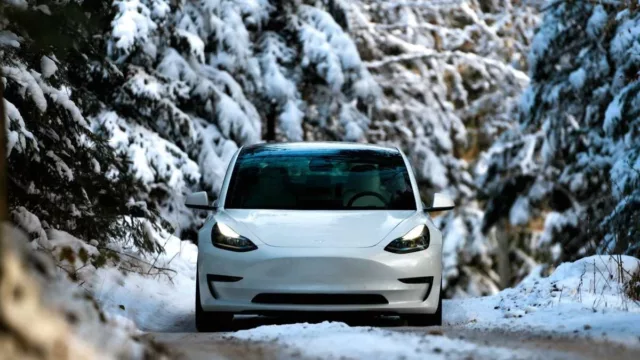
When it comes to electric vehicles (EVs), cold weather presents a significant challenge. Recently, a Norwegian study uncovered something surprising: Teslas—widely regarded as some of the best-performing EVs—struggled in frigid temperatures when compared to their Chinese counterparts. This revelation has sparked discussions in the industry, particularly about the real-world performance of electric cars in winter conditions.
The Tesla Model 3: Struggling in the Cold?
The Tesla Model 3 has long been celebrated for its performance and innovation, but when subjected to the biting cold of Norway, it didn’t quite live up to its usual reputation. As part of the annual El Prix study, 23 EV models were tested on snowy Norwegian roads, with temperatures ranging from -2°C to -10°C. The goal of the test was to compare real-world range with the optimistic WLTP estimates many car manufacturers advertise.
The results were striking. The Tesla Model 3 Long Range, which boasts a substantial 75 kWh battery, managed only 441 km in these conditions—far short of the 629 km promised under the WLTP standards. This 30% gap placed it among the worst performers in the test, just behind the Volkswagen ID.7 at a 31.9% shortfall.
Chinese EVs Show Impressive Performance
On the flip side, Chinese electric vehicles showed a surprising level of efficiency. The HiPhi Z, a relatively unknown luxury sedan in France, managed to travel 522 km on a 120 kWh battery. Its performance exceeded expectations, with a deviation of just -5.9% from its estimated range—remarkably close to the promised numbers.
This surprising outcome calls attention to the growing capabilities of Chinese manufacturers, which continue to push the boundaries of EV technology.
What’s Wrong with the WLTP Standards?
The WLTP (Worldwide Harmonized Light Vehicle Test Procedure) is the standard used to estimate the range of electric vehicles under ideal conditions. However, as the Norwegian study demonstrates, it fails to account for several factors that impact an EV’s performance in the real world, such as cold temperatures, the use of air conditioning, and insulation. This oversight means that the WLTP figures often don’t reflect the reality of driving in more challenging conditions.
As EV adoption grows, car manufacturers will need to rethink their range estimates and offer more realistic figures, especially for cold-climate countries like Norway, where winters are harsh.
A Wake-Up Call for Tesla
The Tesla Model 3’s underperformance in the cold is a blow to the brand, which has long been seen as the gold standard for electric vehicles. Tesla now faces pressure to improve its cold-weather efficiency and address these real-world limitations. While Tesla remains a leader in the EV space, this test shows that even industry giants have areas for improvement.
This test also signals that manufacturers must innovate more than just battery capacity. Winter-specific battery technology will be key to meeting the needs of customers who live in colder climates.
Tips for Optimizing EV Range in Winter
For anyone with an EV, winter can significantly impact battery life and range. However, there are ways to optimize your vehicle’s performance during colder months.
Pre-heat Your Battery
Many newer models allow you to preheat your battery via a mobile app or the car’s onboard display. Just 5–10 minutes of preheating can make a noticeable difference, allowing your car to perform more efficiently right from the start.
Plan Your Route
When possible, choose shorter, smoother routes to conserve energy. Avoid steep inclines or winding roads that demand more power. Always check for charging stations along the way to ensure you can top up when needed.
Tire Pressure
Under-inflated tires can reduce efficiency by up to 10%. Ensure your tires are properly inflated for optimal performance and better traction on icy roads.
Drive Efficiently
Opt for smooth acceleration and braking, and utilize regenerative braking to recapture energy during deceleration. Additionally, minimize the use of energy-hungry accessories like heated seats, cabin heaters, and other power-intensive features. Dress warmly to reduce the need for excessive heating in the car.
Park Smart
Whenever possible, park your car in a warm garage. Cold temperatures can hurt battery performance, and parking in a cold environment can also cause battery damage over time.
Looking Ahead
As the EV market continues to grow, cold-weather performance will likely be a major focus for manufacturers. The challenge now is clear: How can EV makers improve their batteries and efficiency to meet the needs of customers who live in extreme climates? Tesla, along with many others, will need to tackle these issues head-on if they want to stay competitive in the rapidly changing electric vehicle landscape.
The results from Norway’s El Prix study may only be the beginning of a larger conversation about how EVs perform in real-world conditions, not just under controlled testing environments. As more drivers switch to electric cars, especially in colder climates, manufacturers will be forced to innovate and adapt to ensure they’re meeting expectations, not just on paper but in every season.
Similar Posts
The first 10 people to submit it via the form that appears after you share will win a surprise prize!
Good luck









